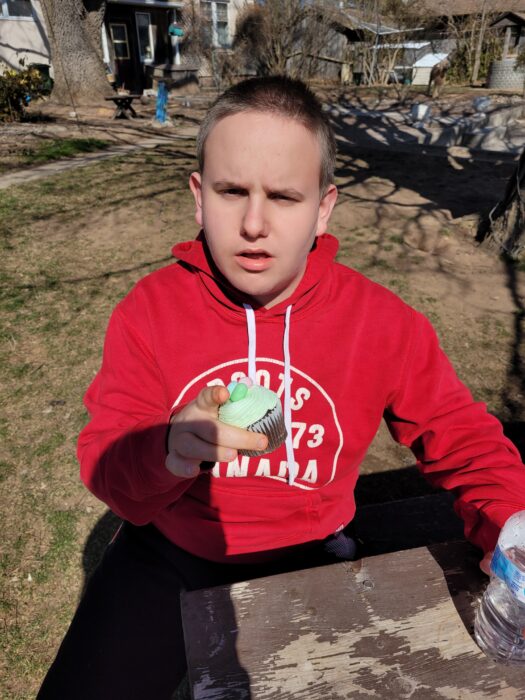
My adopted son was six years old when he first came into my life. He said the same three phrases over and over again. He threw things. He hit people and slapped them and lined up his toy cars as his main form of entertainment.
He couldn’t really talk. He still wasn’t potty trained. He was severely developmentally disabled but he had no specific diagnosis.
Doctors just kept saying he was developmentally delayed. One doctor who even specializes in autism spectrum disorder (ASD) refused to diagnose him with autism.
Finally, six months after I first met my stepson and his father, we got a diagnosis: PDD-NOS. It took countless appointments, phone calls, research and exhaustive tests and conversations to get him the diagnosis. It stands for Pervasive Developmental Disorder – Not Otherwise Specified. It was kind of a catch-all diagnosis for someone who exhibits some autistic traits but doesn’t have “classic” autism. Classic autism usually refers to those who don’t make eye contact and are not able to speak, also known as having “non-verbal autism.” My godson has non-verbal autism yet he is able to read and type words on a computer. He also has very challenging behaviours and is extremely sensitive to sounds and textures on his skin, causing him to have emotional outbursts that are uncontrollable for him and give us a lot of grief from judgmental strangers when we’re out in public.
My stepson Brady was able to look people in the eye. He wasn’t sensitive to sound or touch. In fact, he craves more touch and stimuli than most of us. He spoke a few words when he was six. Because of these traits, even an autism specialist refused to diagnose him with autism. It was ridiculous. Without a proper diagnosis, how is one supposed to obtain the treatments needed specifically for that child’s diagnosis?
That was in 2009 when we finally got the diagnosis. We were put on waiting lists for treatment for Brady but he aged out before he ever got higher up on all the waiting lists. He’s 18 now.
Today, PDD-NOS is no longer used as a diagnosis. That, along with Asperger’s and classic “Kanner’s Autism” are now all combined under one category: autism spectrum disorder (ASD) – because every person with autism is different and their symptoms lie on a spectrum. Asperger’s used to be applied to those with so-called “high-functioning autism.” That is, their language and cognitive development were largely neurotypical but their behaviour and social skills made them exceptional from their peers.
40 or 50 years ago, anyone who was considered severely “odd” and bullied mercilessly by their peers but managed to have advanced language and academic skills would’ve been diagnosed with ASD. It is a complicated neurodevelopmental condition that needs a lot more public understanding and a lot more services and funding for treatment programs. Brady was left out in the cold all these years. So I took matters into my own hands. I toilet-trained him, helped him learn to count and learn the ABC song, spell his name, recite his address and phone number and learn that hitting is completely unacceptable.
His aggression ceased completely when he was nine. Today, he is the happiest, cutest, most adorable teen you could ever hope to meet and interact with. He’s like an angel in human form. He still has his autism traits – like his obsession with watching the move Cars over and over again, his complete obsession with four stuffed animals that he has to take everywhere, and sticking to the exact same routine every day to avoid giving him anxiety. He repeats a lot, all day long. People who aren’t used to it might get frustrated hearing the same questions over and over again all day long but again, this is where the educational part comes into play. He is not repeating to cause frustration for those around him. He is trying to get a need met in the only way he knows. It’s a habit he’ll be unlikely to break in his lifetime. It’s part of his autism.
Brady is a gift. And many other parents of kids with autism believe their kids are gifts, too. They have a unique way of looking at the world that could teach us all lessons on how to be more open-minded, less judgmental and how to see the wonder in even the smallest things.
That doesn’t mean there aren’t any areas for improvement. The goal for many parents is to see their child living up to their fullest potential, with or without autism. What parents of children with autism don’t want is pity or the belief our kids are burdens. Don’t be sad for us. We’re pretty happy with our kids, just like any parent with a neurotypical child. They bring a lot of joy to those around them. They deserve a chance and being seen as the unique, wonderful souls they are.
As April is Autism Awareness Month, I encourage you to learn what you can about autism spectrum disorder. Six Nations Health Services, in partnership with Landsowne Children’s Centre in Brantford, is hosting a Zoom session tonight (Wednesday) at 6 p.m. for those interested in tuning and learning more about autism and local supports.
To register, email larissaskye@sixnations.ca or call 519-761-0534.






